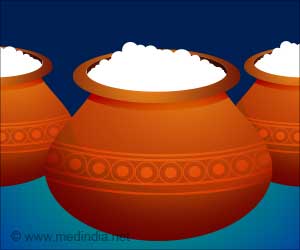-
Two main types of fasting are Nirjala (strict without water) and Phalahar (just fruits) - Avoid grains, pulses, and regular salt; opt for fruits, dairy, and rock salt
- Fasting fosters spiritual growth and enhances mental clarity
Janmashtami, the festival that celebrates the birth of Lord Krishna, is a significant event in the Hindu calendar. Falling on the eighth day of the dark fortnight in the month of Bhadrapada, Janmashtami 2024 will be observed on August 26 (Monday). This festival, derived from ‘Janma’ (birth) and ‘Ashtami’ (eighth day), is marked with great devotion, especially in Mathura, Krishna’s birthplace, and Vrindavan, where he spent his childhood.
One of the core elements of Janmashtami celebrations is fasting, which is observed to purify one’s body and mind (1✔ ✔Trusted Source
Fasting therapy for treating and preventing disease – current state of evidence
).
Advertisement
Types of Fasting That Can be Observed During Janmashtami
1. Nirjala Fasting:
-
The most stringent form of fasting, where devotees abstain from both food and water until midnight, marking the time of Krishna’s birth (2✔ ✔Trusted Source
Sri Krsna Janmastami Vrata ). - The fast is broken with aarti prayers, and mahaprasad food that is offered to the lord, following the birth celebration.
2. Phalahar Fasting:
-
This fast allows fruits, milk, and water. It is intended for those who cannot undertake the Nirjala fast, and for people with health conditions. - Devotees consume a Sattvic (pure) diet, avoiding grains, legumes, onions, and garlic, adhering to the purity that is required during the fasting.
During Janmashtami fasting, grains, pulses, rice, and regular salt are usually avoided. Devotees instead choose non-cereal items like buckwheat, makhana (lotus seeds), and water chestnut flour, using rock salt (sendha namak) instead of regular salt.
Advertisement
Foods You Can Eat Dduring Janmashtami
While fasting, certain foods are allowed to sustain energy and ensure the purity of the fast. Such foods are as follows:
-
Fresh fruits: Bananas, apples, and pomegranates are commonly consumed. - Dairy products: Milk, yogurt, paneer, and butter are integral to the fast and offer essential nutrients.
- Root vegetables: Potatoes and sweet potatoes are often used in preparing vrat (fasting) dishes.
- Nuts and seeds: These provide essential nutrition and energy during the fast.
Advertisement
What to Avoid During Janmashtami Fasting
-
Grains and Cereals: All types of grains and cereals, including wheat, rice, barley, and maize, are strictly prohibited during a Janmashtami fast. - Pulses: Lentils, peas, and beans are also avoided.
- Salt: Regular table salt is not allowed. Instead, rock salt (sendha namak) is used as an alternative.
- Onions and Garlic: These are considered tamasic (impure) and are therefore not consumed during the fast.
- Meat and Eggs: Non-vegetarian food is strictly off-limits during a Janmashtami fasting.
Janmashtami Fast Breaking and Rituals
The Janmashtami fast is accompanied by various rituals, aimed at deepening devotion and spiritual connection:
-
Day-long prayers and bhajans: Devotees engage in singing devotional songs and reciting verses from the Bhagavad Gita or Krishna Leela. - Temple visits: Many visit temples, especially in the evening, to participate in the joyous celebrations of Krishna’s birth.
- Midnight celebration: The fast ends at midnight, symbolizing the moment of Krishna’s birth. Devotees offer prepared food to Krishna, which is then distributed as Prasad (blessed food).
Health Benefits of Nirjala Fasting During Janmashtami
1. Enhanced Meditation
Nirjala fasting improves meditation by enhancing focus and spiritual connection. Abstaining from food and water devotees attain greater control over their senses, making it easier to focus and connect with their spiritual consciousness. Furthermore, it helps to neutralize negative influences and deepen spiritual awareness (3✔ ✔Trusted Source
Significance of Nirjala Ekadashi – Health and Spiritual reason and benefits
).
2. Health and Immunity Boost
As fasting progresses, the digestive system cleanses itself, removing accumulated waste and toxins. This purification process helps prevent indigestion and other digestive-related diseases improving immune function. It helps reset digestion promoting overall health and vitality.
3. Stem Cell Activation
During the fast, the body initiates a cleansing process, eliminating old and damaged cells. This creates space for new stem cells, promoting regeneration and rejuvenation. Regular practice of dry fasting can extend life expectancy, maintain youthfulness, and enhance vitality by 15-25 years.
4. Reduced Inflammation
Fasting lowers inflammatory markers like TNF-α, CRP, and IL-6, reducing risks of chronic diseases. It also creates a hostile environment for harmful microorganisms, enhancing detoxification.
5. Tumor Reduction
During dry fasting, the body undergoes autolysis, where it breaks down non-essential and harmful tissues, such as fat deposits, tumors, and inflamed cells. This process allows the body to prioritize the survival of the strongest and healthiest cells, eliminating irregularities like cysts and benign tumors.
6. High-Quality Metabolic Water
During Nirjala Fasting, the body produces high-quality metabolic water, also known as endogenous water, by cleansing and fortifying it within the cells. This internal water is of superior quality compared to external water, as it has undergone a purification process, making it more beneficial for the body’s tissues. This revitalization process leads to overall rejuvenation, making the body feel younger and more invigorated.
Observing a fast on Janmashtami is more than just abstaining from food; it is an act of devotion, self-discipline, and spiritual cleansing. Whether one chooses a Nirjala or Phalahar fast, the ultimate goal is to honor Lord Krishna, seek his blessings, and attain spiritual growth. Following the prescribed rituals, foods, and fasting rules ensures that devotees stay focused on the divine, making the most of this auspicious day.
References:
- Fasting therapy for treating and preventing disease – current state of evidence
– (https://pubmed.ncbi.nlm.nih.gov/24434759/) - Sri Krsna Janmastami Vrata – (https://www.iskconbangalore.org/wp-content/uploads/2019/02/English-Janmashtami-Vrata-Manual.pdf)
- Significance of Nirjala Ekadashi – Health and Spiritual reason and benefits – (https://holistichealing.org.in/significance-of-nirjala-ekadashi/)
Source-Medindia



